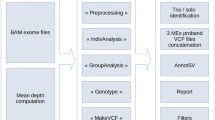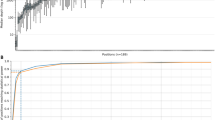Abstract
Aim
To investigate the occurrence of mosaicism in epilepsy probands and their parents using amplicon-based deep sequencing (ADS).
Methods
Patients were recruited from the outpatient of Peking University First Hospital. Two hundred and sixty-four probands with pathogenic variants tested by next-generation sequencing (NGS) were enrolled.
Results
Mosaic variants were detected in seventeen disease-associated genes from 20 probands, 5 paternal, and 6 maternal parents. The frequency of mosaicism was 11.74% (31/264). Mosaicism in 11 genes was identified from 20 probands with the mutant allelic fractions (MAFs) of 12.95–38.00% in autosomal dominant genes. Five paternal mosaicisms were identified in genes with a MAF of 6.30–20.99%, and six maternal mosaic individuals with a MAF of 2.07–21.90%. Only four mosaic parents had milder seizure history. The affected sibling had the same phenotype consistent with that of the proband, who inherited the variant of SLC1A2 or STXBP1 from their unaffected mosaic mothers, respectively.
Interpretation
Mosaic phenomenon is not rare in families with epilepsy. Phenotypes of mosaic parents were milder or normal. Mosaicism detection is helpful to identify the mutation origin and it provides a theoretical basis for prenatal diagnosis of family reproduction. ADS is a reliable way of mosaicism detection for clinical application.
This is a preview of subscription content, access via your institution
Access options
Subscribe to this journal
Receive 12 print issues and online access
$259.00 per year
only $21.58 per issue
Buy this article
- Purchase on Springer Link
- Instant access to full article PDF
Prices may be subject to local taxes which are calculated during checkout





Similar content being viewed by others

References
Dou Y, Yang X, Li Z, Wang S, Zhang Z, Ye AY, et al. Postzygotic single-nucleotide mosaicisms contribute to the etiology of autism spectrum disorder and autistic traits and the origin of mutations. Hum Mutat. 2017;38:1002–13.
Acuna-Hidalgo R, Bo T, Kwint MP, van de Vorst M, Pinelli M, Veltman JA, et al. Post-zygotic point mutations are an underrecognized source of de novo genomic variation. Am J Hum Genet. 2015;97:67–74.
Xu X, Yang X, Wu Q, Liu A, Yang X, Ye AY, et al. Amplicon resequencing identified parental mosaicism for approximately 10% of “de novo” SCN1A mutation in children with Dravet Syndrome. Hum Mutat. 2015;36:861–72.
Liu A, Xu X, Yang X, Jiang Y, Yang Z, Liu X, et al. The clinical spectrum of female epilepsy patients with PCDH19 mutations in a Chinese population. Clin Genet [Internet]. 2016;91:54–62. https://doi.org/10.1111/cge.12846.
Jdila MB, Issa AB, Khabou B, Rhouma BB, Kamoun F, Ammar-Keskes L, et al. Novel mutations in the CDKL5 gene in complex genotypes associated with West syndrome with variable phenotype: First description of somatic mosaic state. Clin Chim Acta [Internet]. 2017;473:51–9. https://doi.org/10.1016/j.cca.2017.08.001.
Olson HE, Tambunan D, Lacoursiere C, Goldenberg M, Pinsky R, Martin E, et al. Mutations in epilepsy and intellectual disability genes in patients with features of Rett syndrome. Am J Med Genet Part A. 2015;167:2017–25.
Zhang Q, Yang X, Wang J, Li J, Wu Q. Genomic mosaicism in the pathogenesis and inheritance of a Rett syndrome cohort. Genet Med [Internet]. 2019;21:2–10. https://doi.org/10.1038/s41436-018-0348-2.
Nathan N, Keppler-Noreuil KM, Biesecker LG, Moss J, Darling TN. Mosaic disorders of the PI3K/PTEN/AKT/TSC/mTORC1 signaling pathway. Dermatol Clin [Internet]. 2017;35:51–60. https://doi.org/10.1016/j.det.2016.07.001.
Yang X, Liu A, Xu X, Yang X, Zeng Q, Ye AY, et al. Genomic mosaicism in paternal sperm and multiple parental tissues in a Dravet syndrome cohort. Sci Rep [Internet]. 2017;7:15677. http://www.ncbi.nlm.nih.gov/pmc/articles/PMC5688122/.
Yang X, Yang X, Chen J, Li S, Zeng Q, Huang AY, et al. ATP1A3 mosaicism in families with alternating hemiplegia of childhood. Clin Genet. 2019;96:43–52.
Xu X, Yang X, Wu Q, Liu A, Yang X, Ye AY, et al. Amplicon resequencing identified parental mosaicism for approximately 10% of “de novo” SCN1A mutations in children with Dravet Syndrome. Hum Mutat. 2015;36:861–72.
Liu A, Yang X, Yang X, Wu Q, Zhang J, Sun D, et al. Mosaicism and incomplete penetrance of PCDH19 mutations. J Med Genet. 2018;56:81–8.
Campbell IM, Yuan B, Robberecht C, Pfundt R, Szafranski P, Mcentagart ME, et al. Parental somatic mosaicism is underrecognized and influences recurrence risk of genomic disorders. Am J Hum Genet. 2014;95:173–82.
Depienne C, Arzimanoglou A, Trouillard O, Fedirko E, Baulac S. Parental mosaicism can cause recurrent transmission of SCN1A mutations associated with severe myoclonic epilepsy of infancy. Hum Mutat. 2006;27:389.
Chen WW, Balaj L, Liau LM, Samuels ML, Kotsopoulos SK, Maguire CA, et al. BEAMing and droplet digital PCR analysis of mutant IDH1 mRNA in glioma patient serum and cerebrospinal fluid extracellular vesicles. Mol Ther Nucleic Acids. 2013;2:e109.
Myers CT, Hollingsworth G, Muir AM, Schneider AL, Knupp ZTA, King C. Parental mosaicism in “ de novo” epileptic encephalopathies. N Engl J Med. 2018;378:1646–8.
Stosser MB, Lindy AS, Butler E, Retterer K, Piccirillo-Stosser CM, Richard G, et al. High frequency of mosaic pathogenic variants in genes causing epilepsy-related neurodevelopmental disorders. Genet Med [Internet]. 2017;00:1–8. http://www.nature.com/doifinder/10.1038/gim.2017.114.
Gambin T, Liu Q, Karolak JA, Grochowski CM, Xie NG, Wu LR, et al. Low-level parental somatic mosaic SNVs in exomes from a large cohort of trios with diverse suspected Mendelian conditions. Genet Med. 2020;Online ahe(0).
Weckhuysen S, Mandelstam S, Suls A, Audenaert D, Deconinck T, Claes LRF, et al. KCNQ2 encephalopathy: emerging phenotype of a neonatal epileptic encephalopathy. Ann Neurol. 2012;71:15–25.
Milh M, Lacoste C, Cacciagli P, Abidi A, Sutera-Sardo J, Tzelepis I, et al. Variable clinical expression in patients with mosaicism for KCNQ2 mutations. Am J Med Genet Part A. 2015;167:2314–8.
Zerem A, Lev D, Blumkin L, Goldberg-Stern H, Michaeli-Yossef Y, Halevy A, et al. Paternal germline mosaicism of a SCN2A mutation results in Ohtahara syndrome in half siblings. Eur J Paediatr Neurol. 2014;18:567–71.
Samuels ME, Friedman JM. Genetic mosaics and the germ line lineage. Genes (Basel). 2015;6:216–37.
Huang AY, Xu X, Ye AY, Wu Q, Yan L, Zhao B, et al. Postzygotic single-nucleotide mosaicisms in whole-genome sequences of clinically unremarkable individuals. Cell Res [Internet]. 2014;24:1311–27. https://doi.org/10.1038/cr.2014.131.
Acknowledgements
We thank the patients and their family members for taking part in this study. This study was supported by the Key Research Project of the Ministry of Science and Technology of China (Grant No. 2016YFC0904400 and 2016YFC0904401). We would like to thank Dr. Jiapeng Zhou and Dr. Xiaodong Wang for their assistance in editing the manuscript.
Author information
Authors and Affiliations
Corresponding author
Ethics declarations
Competing interests
The authors declare no competing interests.
Ethics approval
This study was approved by the ethics committee of Peking University First Hospital and has been performed in accordance with the ethical standards laid down in the 1964 Declaration of Helsinki and its later amendments.
Additional information
Publisher’s note Springer Nature remains neutral with regard to jurisdictional claims in published maps and institutional affiliations.
Rights and permissions
Springer Nature or its licensor (e.g. a society or other partner) holds exclusive rights to this article under a publishing agreement with the author(s) or other rightsholder(s); author self-archiving of the accepted manuscript version of this article is solely governed by the terms of such publishing agreement and applicable law.
About this article
Cite this article
Chen, J., Chen, Y., Yang, Y. et al. Detecting genomic mosaicism in “de novo” genetic epilepsy by amplicon-based deep sequencing. J Hum Genet 68, 73–80 (2023). https://doi.org/10.1038/s10038-022-01103-3
Received:
Revised:
Accepted:
Published:
Issue Date:
DOI: https://doi.org/10.1038/s10038-022-01103-3


